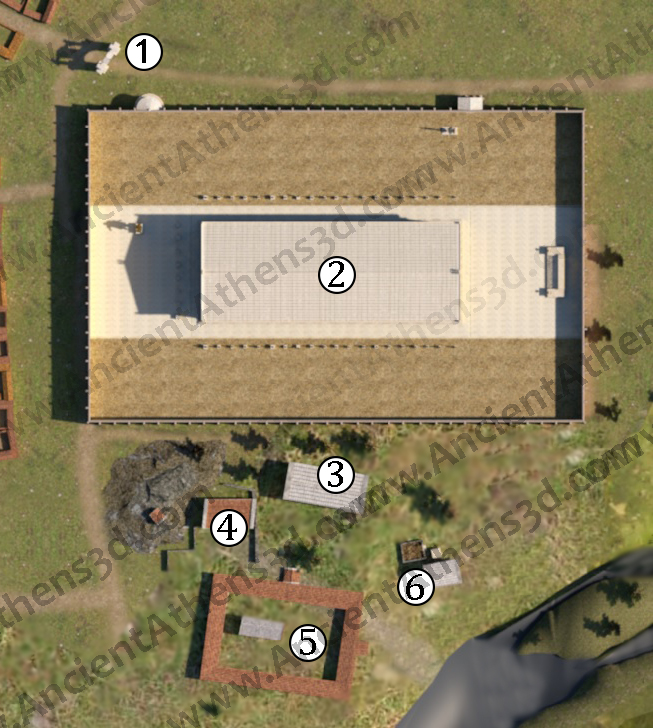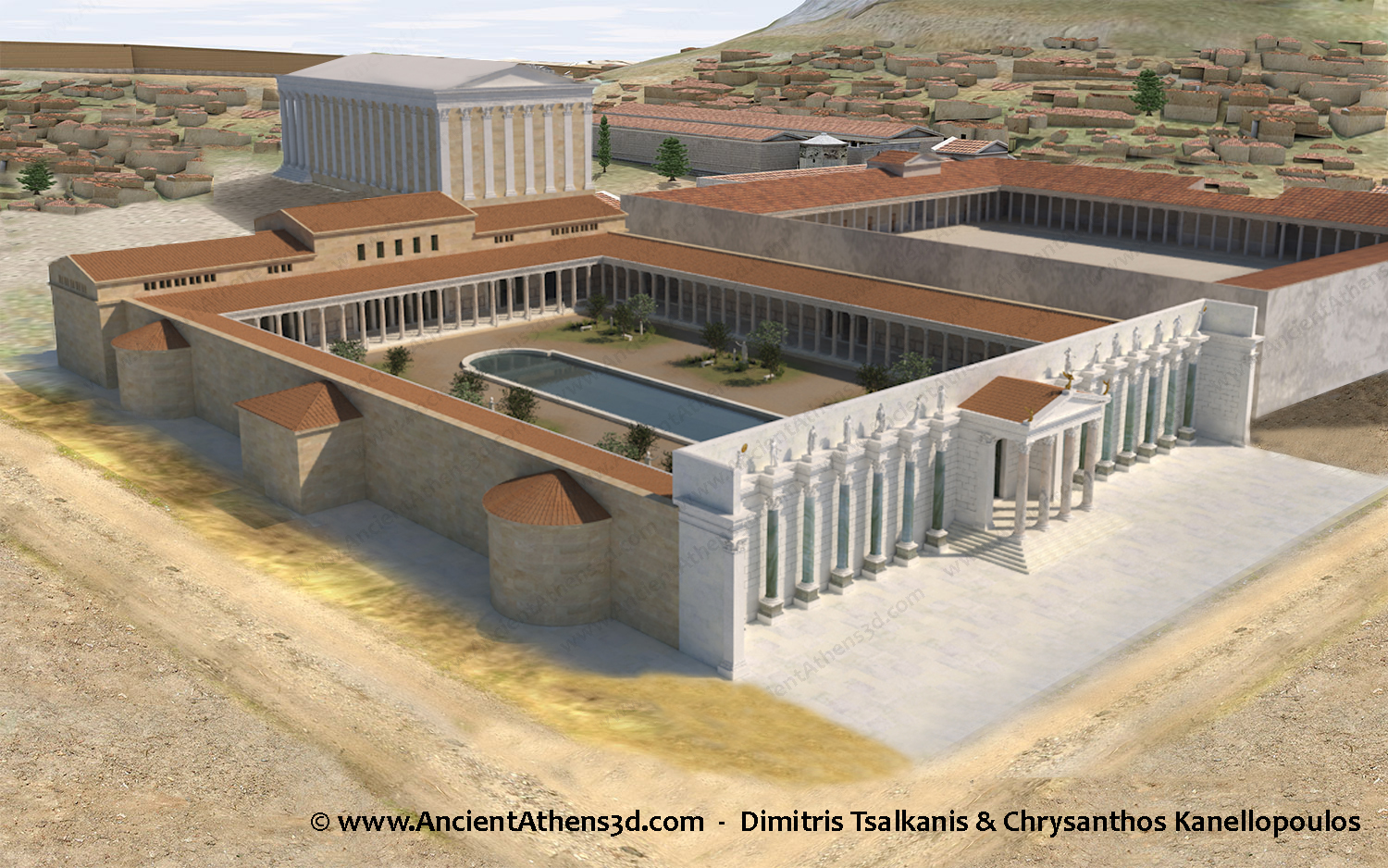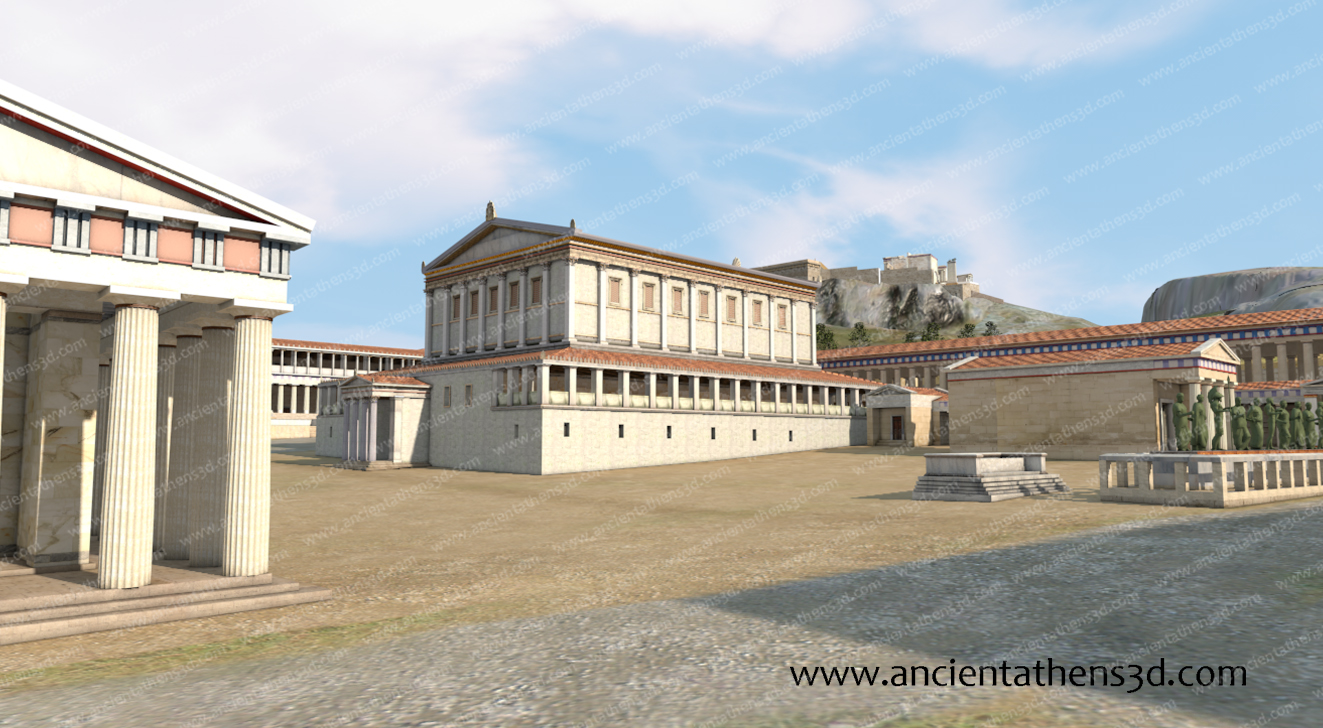The Olympieion and the Arch of Hadrian
Emperor Hadrian visited Athens in 130-131 AD and stayed for several months. His arrival was combined with a brilliant fact: ηe inaugurated the Temple of Zeus Olympios the construction of which he financed. Thus, the temple was finally completed with a delay of approximately 600 years. At the same period, the Athenians in order to honour the arrival of the emperor, they erected next to the Olympieion an arch, today known as the Arch of Hadrian. The Roman emperor also built more sanctuaries south of the Olympieion. The most important of these was the sanctuary of Zeus Panhellenios.
CREDITS:
The models of the reconstructions were created by Dimitris Tsalkanis for Ancient Athens 3d under the survey and advice of Chrysanthos Kanellopoulos, professor of Archaeology in the University of Athens. The 3d models of the statues are by: Scan The World, Christian Levett and The Mougins Museum, Nate Siddle (myminifactory.com & sketchfab.com).
The Olympieon (124-131 AD)
The construction of the Temple of Zeus Olympios began in the archaic period by Peisistratos and his descendants (520 BC). It was designed to look like the huge temples of Asia Minor. It would be a Doric temple with a foundation size of 41m x 108m. It would have eight columns in two rows in the narrow sides and 21 in the long ones. However, with the arrival of Democracy, it was considered as a symbol of tyranny and the construction stopped.
In the Hellenistic years, the king of the Seleykid Empire, Antiochus IV Epiphanes, ordered in 174 BC the reconstruction of temple. The assigned architect was the Roman Cossutius who modified the initial plan of the building. The temple would now be of Corinthian order. In the narrow sides it would have three rows of 8 columns each, while in the long ones, there would be two rows of 20. It would have 104 columns in total. However, the works stopped again after the death of Antiochus, in 164 BC. In 86 BC, when the Romans besieged Athens, general Sylla took two columns of the unfinished temple to decorate the temple of Jupiter in Campidoglio, in Rome. A third effort for the completion of the temple made by Augustus, was unsuccessful. Finally, the emperor Hadrian accomplished the project in 131 AD. He respected the initial plan of Cossutius even keeping some of his columns which still stood. The columns were 17 metres high and had a diameter of 2m. A wall was built around the temple along which, dozens of his portraits were placed as offerings by all the cities of Greece. In the interior of temple there was one gold and ivory statue of Zeus and one of Hadrian himself. The temple was deserted after suffering serious damage from their Heruli invasion in 267 AD. Afterwards it was used as a quarry, as the marble was used to manufacture lime. In 1436, only 21 columns had remained of the 104. On 27 April 1759 the Turkish governor of Athens Tsisdarakis blew up one column in order to he prepare lime for the mosque that he was building. Today only 16 columns exist. One of them fell during a storm in 1852.The ancient writer and traveller Pausanias visited the Olympieion a few years after its completion and described it:
| Ἀδριανὸς ὁ Ῥωμαίων βασιλεὺς τόν τε ναὸν ἀνέθηκε καὶ τὸ ἄγαλμα θέας ἄξιον, οὗ μεγέθει μέν, ὅτι μὴ Ῥοδίοις καὶ Ῥωμαίοις εἰσὶν οἱ κολοσσοί, τὰ λοιπὰ ἀγάλματα ὁμοίως ἀπολείπεται, πεποίηται δὲ ἔκ τε ἐλέφαντος καὶ χρυσοῦ καὶ ἔχει τέχνης εὖ πρὸς τὸ μέγεθος ὁρῶσιν Πρὶν δὲ ἐς τὸ ἱερὸν ἰέναι τοῦ Διὸς τοῦ Ὀλυμπίου, ἐνταῦθα εἰκόνες Ἀδριανοῦ δύο μέν εἰσι Θασίου λίθου, δύο δὲ Αἰγυπτίου· χαλκαῖ δὲ ἑστᾶσι πρὸ τῶν κιόνων ἃς Ἀθηναῖοι καλοῦσιν ἀποίκους πόλεις. ὁ μὲν δὴ πᾶς περίβολος σταδίων μάλιστα τεσσάρων ἐστίν, ἀνδριάντων δὲ πλήρης· (…) Ἀπὸ γὰρ πόλεως ἑκάστης εἰκὼν Ἀδριανοῦ βασιλέως ἀνάκειται, καὶ σφᾶς ὑπερεβάλοντο Ἀθηναῖοι τὸν κολοσσὸν ἀναθέντες ὄπισθε τοῦ ναοῦ θέας ἄξιον. Κεῖται δὲ ἐπὶ κίονος Ἰσοκράτους ἀνδριάς, (…) κεῖνται δὲ καὶ λίθου Φρυγίου Πέρσαι χαλκοῦν τρίποδα ἀνέχοντες, θέας ἄξιοι καὶ αὐτοὶ καὶ ὁ τρίπους. (Παυσανίου Ελλάδος Περιήγησις – Αττικά, 18.4-18.8) | Hadrian the Roman emperor dedicated the temple and the statue, one worth seeing, which in size exceeds all other statues save the colossi at Rhodes and Rome, and is made of ivory and gold with an artistic skill which is remarkable when the size is taken into account Before the entrance to the sanctuary of Olympian Zeus, stand statues of Hadrian, two of Thasian stone, two of Egyptian. Before the pillars stand bronze statues which the Athenians call “colonies.” The whole circumference of the precinct is about four stades, and they are full of statues; for every city has dedicated a likeness of the emperor Hadrian, and the Athenians have surpassed them in dedicating, behind the temple, the remarkable colossus. On a pillar is a statue of Isocrates (…) there are also statues in Phrygian marble of Persians supporting a bronze tripod; both the figures and the tripod are worth seeing. (Pausanias Description of Greece – Attica, 18.4-18.8 – English Translation by W.H.S. Jones, Litt.D. and H.A. Ormerod) |
Arch of Hadrian (131-132 AD)
Hadrian founded the eastern part of Athens, around the area of the Olympieion. It was a new district that was named after him: Hadrianoupolis. When the emperor reached Athens in AD 131, the residents of the city dedicated an arch to him, located in the border between the old city and the new one.
This arch is still preserved in excellent condition. It is of Corinthian order and it’s height is 18 metres, the width 13,5m and the depth 2,3m. It is made of Pentelic marble. The arch in the middle has a span of 6,5 metres. Above this, two inscriptions can be found on both sides. The western reads: ΑΙΔ’ ΕΙΣ’ ΑΘΗΝΑΙ ΘΗΣΕΩΣ Η ΠΡΙΝ ΠΟΛΙΣ (This is Athens, the old city of Theseus) while the eastern reads: ΑΙΔ’ ΕΙΣ’ ΑΔΡΙΑΝΟΥ ΚΑΙ ΟΥΧΙ ΘΗΣΕΩΣ ΠΟΛΙΣ (This is the city of Hadrian and not of Theseus).Other buildings

















